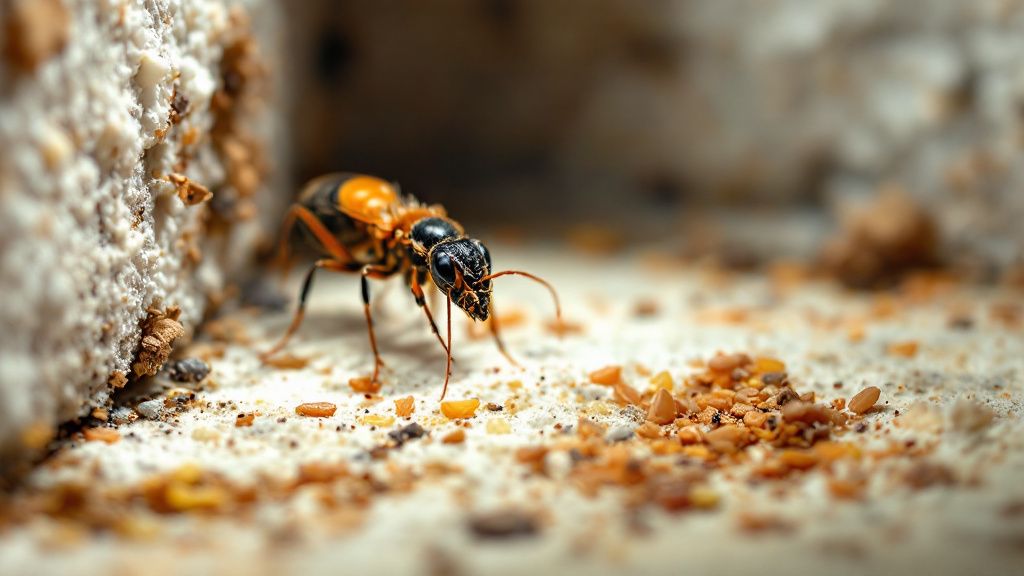Imagine your home fortified against uninvited guests, protected by a shield that enhances its longevity. Pest resistant insulation serves as this guardian, significantly enhancing your home’s durability by thwarting common pests. With a range of options available, such as pest resistant foam insulation, you benefit not only from efficient thermal properties but also from robust pest control insulation features. Integrating the best insulation for pest control doesn’t just defend your home but also ensures a comfortable environment year-round. Learning how to install pest resistant insulation allows you to tailor it exactly to your needs, optimizing both energy efficiency and pest prevention. Explore the types of pest resistant insulation to find the perfect match that offers comprehensive benefits, reinforcing your home’s structural integrity while reducing maintenance hassles. Embrace the transformation with this dual-purpose solution that not only supports your home’s durability but also fortifies against future pest invasions.
Understanding Pest Resistant Insulation
Pest resistant insulation is a specialized type of insulation designed to prevent pest intrusions. Its unique structure incorporates materials that deter pests without using harmful chemicals. According to recent studies, certain insulation materials like borate-treated cellulose are effective in pest prevention, providing a dual advantage of thermal insulation and pest control. This scientific approach illustrates how such materials can serve as a formidable barrier, reducing the likelihood of infestations in homes.
Exploring the types of pest resistant insulation, you’ll find options like foam insulation with pest-deterrent additives. These products are carefully engineered to withstand infiltration by insects and rodents. Understanding these different types empowers you to select the best insulation for pest control based on specific needs and environmental conditions. The thoughtful selection of insulation not only targets energy efficiency but also contributes significantly to pest prevention.
The benefits of pest resistant insulation extend beyond pest control. This insulation type significantly enhances home durability and can reduce maintenance costs over time. The structural integrity of your space is supported by absorbing less moisture, diminishing areas where pests might thrive. It’s a sensible investment that integrates pest control with environmental benefits, offering peace of mind to homeowners everywhere.
When considering how to install pest resistant insulation, proper installation techniques are crucial. Whether you choose professional installation or a DIY approach, ensuring correct placement amplifies pest deterrent properties. Incorporate this insulation as a cornerstone of your home maintenance plan, embracing a strategy that merges comfort with comprehensive pest resistance.

Benefits of Pest Resistant Insulation
Pest resistant insulation offers numerous advantages that enhance both the functionality and comfort of your living space. This innovative insulation not only combats unwanted pests but also contributes to energy efficiency, keeping your home warm in the winter and cool in the summer. By reducing energy consumption, it supports a greener lifestyle while saving on utility bills. The benefits of installing this type of insulation extend well beyond simple pest deterrence.
Choosing the best insulation for pest control, like pest resistant foam insulation, integrates seamlessly into your home, offering substantial protection against insects and rodents. This added layer of security means fewer pest-related repairs, extending the lifespan of your home’s structural elements. As you consider insulation materials, remember that some types are designed specifically for durability and enhanced pest deterrence.
Exploring how to install pest resistant insulation reveals that it doesn’t just offer immediate benefits but also promises long-term gains. In the next few years, homes that feature this type of insulation are likely to see increased property values due to its dual-purpose functionality. The investment you make in pest control insulation today sets the stage for a resilient and sustainable living environment as demand for such systems grows.
Embedding pest resistant insulation into your home’s infrastructure is a strategic move for insulation for pest prevention. The implementation of such advanced solutions solidifies your home’s defenses against damage while maintaining a comfortable environment. It’s an approach that not only offers pragmatic benefits but also aligns with forward-thinking home design, emphasizing protection and efficiency.

Common Pests Targeted by Insulation
What types of pests can pest resistant insulation effectively deter? Understanding the specific pests that this insulation targets can help you make informed decisions for your home. Common culprits include rodents like mice and rats, which often seek refuge in warm, insulated spaces. Termites and carpenter ants are also notorious for causing structural damage, making pest resistant insulation a valuable barrier against these destructive insects.
Pest resistant foam insulation is crafted to thwart these unwanted intruders by blocking entry points and creating unfavorable conditions for nesting. These materials aren’t just barriers; they’re deterrents that minimize the chances of infestations. The best insulation for pest control maximizes resistance against penetration while maintaining its primary function of temperature regulation.
In addition to rodents and insects, some pest resistant insulation is designed to deter larger pests like raccoons and squirrels from nesting within walls and attics. These critters can wreak havoc by chewing through traditional insulation materials. Choosing the right insulation for pest prevention strengthens your home’s defenses and reduces the frequency of repairs caused by animal invasions.
Learning how to install pest resistant insulation ensures optimal coverage and efficacy. Proper installation focuses on sealing gaps and overlaps to create a seamless barrier. It’s essential to identify the types of pest resistant insulation best suited for your specific pest concerns, considering factors like climate, home size, and known pest inhabitants in your area.
By installing pest control insulation, you enhance your home’s durability while safeguarding it against common pests. This dual-purpose solution not only protects your walls and attics but also provides peace of mind. The integration of such insulation materials forms an active part of your home maintenance strategy, addressing both comfort and pest management in a single effort.
Installation Process for Pest Resistant Insulation
Proper installation of pest resistant insulation is key to maximizing its protective benefits. Preparing the area by sealing cracks and gaps ensures the insulation material can function effectively. This process requires precise measurements and careful placement to create a seamless shield against pests. Understanding how to install pest resistant insulation correctly helps in achieving consistent energy efficiency and fortification against common household pests.
While many believe that any insulation can serve as a pest barrier, there’s a strong case for selecting specialized pest control insulation. This type is specifically formulated to deter pests, combining insulation materials with pest-resistant properties. It’s essential to understand that using general-purpose insulation might not afford the same level of protection, particularly in pest-prone areas.
Utilizing pest resistant foam insulation involves injecting or placing it into wall cavities and attics. This method effectively seals off potential entry points for insects and rodents. During installation, it’s important to pay attention to areas that are most vulnerable to infestation, ensuring every inch is covered securely, which ultimately supports both pest prevention and insulation effectiveness.
Choosing the right types of pest resistant insulation for your specific needs enhances your home’s longevity. Each type offers its unique set of attributes, catering to different climates and pest challenges. By implementing these products, you not only address the immediate need for pest exclusion but also contribute to sustaining the structural integrity of your space over time.
Comparing Insulation Options
Exploring different insulation options highlights the unique strengths of pest resistant insulation compared to conventional insulation materials. Traditional insulation often focuses solely on thermal efficiency, whereas pest control insulation offers the added benefit of deterring infestations. When considering insulation for pest prevention, you’re choosing a product that not only regulates temperature but also integrates pest resistance, offering a dual advantage that standard materials may not provide.
Comparing pest resistant insulation and pest resistant foam insulation reveals distinct features suited to various applications. Foam insulation offers superior sealing capabilities, filling crevices and gaps that pests commonly exploit. This type of insulation acts as both a thermal barrier and a strong deterrent against pest invasions. Meanwhile, other types of pest resistant insulation, like treated cellulose, provide excellent fire resistance along with pest deterrence, catering to different protection needs.
Making the right choice involves weighing the pest resistant insulation benefits against other insulation options. It’s important to consider the specific needs of your environment, such as common pest threats and climate conditions. By comparing these factors, you empower yourself to select the best insulation for pest control that aligns with your goals for home durability and comfort, ensuring long-term efficacy and peace of mind.
Maintenance Tips for Long-Term Pest Resistance
Effective maintenance of pest resistant insulation ensures that your home remains fortified against unwanted intrusions over the long haul. Regular inspections should be part of your routine, focusing on identifying any breach points or gaps that might compromise its effectiveness. Monitoring the condition of your insulation materials is key to preventing pest invasions and maintaining optimal thermal performance, ensuring the insulation continues to perform at its best.
Addressing any damage promptly is crucial. If you notice areas where pests have attempted entry, repairing these spots can prevent further incursions. Using pest resistant foam insulation for patching up gaps can offer a quick and effective fix, providing an added layer of security against both thermal loss and pest intrusions. It’s an important step in insulation for pest prevention that doesn’t take much time but yields significant peace of mind.
Implementing pest control measures around your home complements the protection offered by your insulation. Securing your property’s perimeter by sealing entry points, decluttering spaces, and maintaining cleanliness can help deter pests from ever reaching your insulation. In the next few years, enhanced smart home technologies are likely to include integrated pest detection systems, providing homeowners with advanced tools to manage and prevent pest infestations more effectively.
Setting up a regular maintenance schedule ensures your pest resistant insulation remains in optimal condition. Seasonal checks can help address potential vulnerabilities before they become serious issues, preserving both energy efficiency and your home’s structural integrity. By staying proactive, you maximize the pest resistant insulation benefits, creating a living environment that’s resilient, comfortable, and secure against pest threats.


